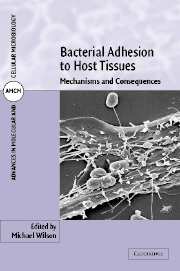Book contents
- Frontmatter
- Contents
- List of contributors
- Preface
- Part I Bacterial adhesins and adhesive structures
- 1 Surface protein adhesins of staphylococci
- 2 Mechanisms of utilization of host signalling molecules by respiratory mucosal pathogens
- 3 Adhesive surface structures of oral streptococci
- 4 Regulation and function of phase variation in Escherichia coli
- 5 Regulation of capsule expression
- 6 Role of pili in Haemophilus influenzae adherence, colonization and disease
- Part II Effect of adhesion on bacterial structure and function
- Part III Consequences of bacterial adhesion for the host
- Index
- Plate section
3 - Adhesive surface structures of oral streptococci
Published online by Cambridge University Press: 08 October 2009
- Frontmatter
- Contents
- List of contributors
- Preface
- Part I Bacterial adhesins and adhesive structures
- 1 Surface protein adhesins of staphylococci
- 2 Mechanisms of utilization of host signalling molecules by respiratory mucosal pathogens
- 3 Adhesive surface structures of oral streptococci
- 4 Regulation and function of phase variation in Escherichia coli
- 5 Regulation of capsule expression
- 6 Role of pili in Haemophilus influenzae adherence, colonization and disease
- Part II Effect of adhesion on bacterial structure and function
- Part III Consequences of bacterial adhesion for the host
- Index
- Plate section
Summary
INTRODUCTION
The oral cavity
The human oral cavity is home to a large and diverse microbial population. The mouth provides a wide range of different habitats for bacterial colonization and growth, including hard, non-shedding surfaces (the teeth) as well as various epithelial surfaces such as the tongue dorsum and buccal mucosa. The composition of the bacterial flora at these different sites can vary considerably, reflecting the range of surfaces for attachment and environmental conditions that are available for growth. Nevertheless, streptococci, which comprise some 20% of the human normal oral flora, can be isolated from most oral sites (Nyvad and Kilian, 1987; Frandsen et al., 1991). Streptococci, together with Actinomyces species, are the predominant organisms found in the early stages of biofilm (i.e. dental plaque) formation on tooth surfaces, and the interactions of these initial species with the salivary pellicle may define the strength of biofilm adhesion (Busscher et al., 1995). Furthermore, the streptococci participate in a wide range of intraand inter-generic coaggregation interactions that help to establish early biofilm communities (Kolenbrander and London, 1993; Kolenbrander, 2000). Consequently, streptococci play an important role in plaque development.
Oral streptococcal species have recently undergone considerable taxonomic upheaval (see Whiley and Beighton, 1998). This has resulted not only in the reclassification of species and the description of new species, but also the grammatical correction of Latin species epithets (thus Streptococcus crista has been renamed S. cristatus, and Streptococcus parasanguis is now S. parasanguinis). For this chapter we have chosen to retain the epithets in long-term usage.
- Type
- Chapter
- Information
- Bacterial Adhesion to Host TissuesMechanisms and Consequences, pp. 59 - 88Publisher: Cambridge University PressPrint publication year: 2002
- 1
- Cited by



